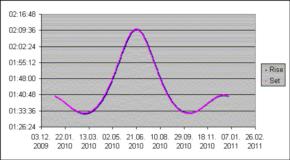
NavList:
A Community Devoted to the Preservation and Practice of Celestial Navigation and Other Methods of Traditional Wayfinding
Fw: Re: shortest twilight problem...
From: George Huxtable
Date: 2010 Jun 29, 16:33 +0100
From: George Huxtable
Date: 2010 Jun 29, 16:33 +0100
Well, it seems that this response to an apparently simple question from Joel Silverberg has become a somewhat inglorious eoisode in the history of Navlist. I started off the rot by writing solstices, when I meant to say equinoxes. Then Marcel seems to have made a double error, which happened to cancel out, and got the right answer for the wrong reasons. ======================= The story so far. The situation so far is that we seem to agree that there is a maximum in the length of twilight at each solstice, and a minimum near each equinox. But note that now I say near each equinox, not at each equinox, because my view has now changed significantly. Rather belatedly, I realise that the question of shortest twilight, that Joel posed, is not so trivial after all. I now think that all told, we (or at least, I) have been jumping to confusions. It's true that there's a maximum twilight length around each solstice, which is defined simply by symmetry. (Here, I'm neglecting effects caused by the eccenticity of the Earth's orbit, which perhaps shouldn't be neglected). But those maxima are very different in twilight length, between Summer and Winter solstice, as Marcel's graph shows. And that asymmetry, between Summer and Winter, affects the symmetry of the minimum, around the equinoxes, as is also shown in Marcel's plot. My initial response, that the matter was a trivial one, was based on my understanding that the rate-of-fall of the Sun as it crosses the horizon is greatest at the equinox: as indeed it is. But Joel's question was about the time taken for its altitude to fall from 0º to -18º, which is not symmetrical about the horizon line. If we had been asked about the time for the altitude to fall from +1º to -1º, or even from +18º to -18º, we could confidently say that those intervals would minimise at the equinox. Not so, however, between 0º and -18º If you look carefully at Marcel's plot, which I recopy here, you will see that the dates of the mimima are indeed shifted from the dates of the equinoxes. Which makes Joel's question a lot more entertaining. Our answers have fallen short. George. contact George Huxtable, at george@hux.me.uk or at +44 1865 820222 (from UK, 01865 820222) or at 1 Sandy Lane, Southmoor, Abingdon, Oxon OX13 5HX, UK.







